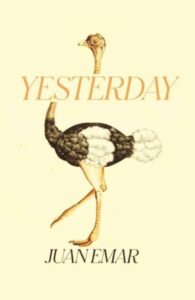
Tr. from the Spanish by Megan McDowell
[New Directions Press; 2022]
As its title suggests, Chilean writer Juan Emar’s Yesterday, like those twin pillars of modernist fiction, Ulysses and Mrs. Dalloway, takes place over the course of a single day. Written in past-tense from the perspective of an unnamed narrator—lulling the reader into assuming that some version of Emar himself inhabits the “I”—the bulk of Yesterday’s 143 pages read like linked short stories. Starting with the public beheading of a man for deriving too much pleasure from sex with his wife, to the narrator directing his stream clockwise around the holes in a urinal while contemplating swatting a fly, these incidents teeter between the mundane and the unreal, bearing little to no causal relationship to one another. That they happen to occur all on the same day, in the same city (the fictional San Augustín de Tango), to the same people (the narrator and his unnamed wife), is all that holds them together, steeping the novel in a sense of the arbitrary that perturbs even the narrator. In the final pages, the formal pattern shifts as the narrator reflects on the day’s goings-on before bed, repeatedly failing to integrate them into the meaningful synopsis he has promised his wife, who waits in the next room. In a fog of hypnagogia, digressions and tangents corrupt his memories. The exhaustive unraveling of his attempts to make sense of the day reveals one of Yesterday’s constitutive obsessions: how thought, confronted with the enigma of time, cannot help but unspool, stretch, and splice back together, forming a story one way or another. Even if that turns out to be a story about contingency itself.
In terms of storytelling doctrine, a day-in-the-life framing is a counterintuitive move, though one that is well-adapted to a stream of consciousness. Shedding the armature of a cause-and-effect plot frees the narration to core-sample consciousness with all its overthrusting strata. Except that Yesterday is not, strictly speaking, an exercise in stream of consciousness, though Emar wrings his hands as much as Joyce or Woolf over the mind’s inner-workings. Emar crams this particular day-in-the-life with spectacles, multicourse meals, visits to friends and family, and philosophical daydreams. The mind is at its most receptive, its most imaginative, he suggests, when at leisure.
In a day made up of strange incidents, what may be the strangest takes place in the morning during a visit to the zoo. There the narrator and his wife sing along with a chorus of monkeys in praise of the sun, but it isn’t until they move on to the ostrich that reality warps to the point of collapse. “What happens in the depths of a man,” ponders the narrator, entranced, “what unconsciousness awakens within him . . . to bring forth the spark of delight that wells up at the poised step of an ostrich?” His question does not go unanswered for long.
From a nearby enclosure a lioness escapes, sending the crowd into a panic, and begins to stalk the ostrich. From their vantage point up a tree, the narrator and his wife observe as the lioness pounces. In the last instant, the ostrich defies physical laws and sidesteps, opening its beak to swallow the lioness whole. Like a snake’s prey, she passes slowly down the ostrich’s throat, through its body, and out the other side, alive but half-skinned by the sphincter. This grotesque reversal of predator and prey figuratively recapitulates the beheading that opens the novel, turning reality upside down and inside out.
Despite the nod earlier to awakened unconsciousness, this scene bears little resemblance to classical Surrealism. Emar shies away from automatism, or at least from any outward appearance of involuntary composition. There’s clearly a methodology at play, one that arguably satisfies Darko Suvin’s criterion for science fiction by provoking cognitive estrangement. As if at pains to impart a realistic rigor to the patently unreal, the narrator describes the scene in absurd, diagrammatic intricacy:
If I knew how to draw, I would draw an ostrich just as it appeared before the step to the right, and then, in the same drawing, I would use a dotted line to draw the creature’s position after the step. Unfortunately, I don’t know how to draw. But, I repeat, if I did know how to draw, two ostrich bodies would be seen in the drawing, one at the center of the paper, another to the side, to the right . . .
With a technique analogous to slow-motion, he pads out the instant with an excess of words, forestalling the pounce. The effect heightens suspense but also artifice as Emar flaunts the circumlocutions of language, the malleability of time. The ostrich’s sidestep triggers a memory from outside the day’s confines, that of a bullfight in Zaragosa, splitting the instant into two simultaneous experiences: one beside his wife up a tree, another with a former lover, Lucretia. Chilean present and Spanish past interfuse.
Emar pushes his digressive method to extremes when the narrator and his wife pay an afternoon visit to his family. They arrive at his parents’ house to find the entire family (along with the Uruguayan consul, whose malign presence remains tantalizingly unexplained) in stitches, having struck a bet that the narrator will be too frightened to look at a mystery object concealed behind the sofa. The narrator obsessively details his reason for not looking, despite assurances from his rational mind that he has nothing to fear, least of all his deepest fear—having to confront his “counterpart fixed in gelatin.”
The episode turns into an exercise in ratcheting up narrative tension while withholding any payoff. Littered along the way, the digressions turn out more satisfying than the unrevealed reveal, as the narrator babbles out an excursus on the dynamics of his subconscious, the “nerves and antennae that are beyond my control, the ones that send me only foggy, disguised messages that I assimilate without deciphering.” Such undeciphered messages lurk not only in the ostrich’s sidestep, but in the novel’s subtler incidents. The narration treats them with a feigned naïveté—Emar showing his hand from behind the “I”. What ultimately holds the narrator back is “the fear of finding [them] swept up in a succession of states of mind that, starting with [their] first impression at the start of the gelatinous thing and then snowballing would lead [them] right smack into the madhouse.” Disguised as rationality, irrational fear triumphs, drawing the narrator’s reliability into question.
The porosity of the narrator’s rational mind, its susceptibility to incursion by the irrational, offers the reader a glimpse into the mechanism behind the strange incidents of the novel. They unfold already tinged with the unreal, the irrational—with mental permutations. Present and past and outer and inner realities congeal into one linguistic mass. As it turns out, Yesterday does not take place in one day, or not the day we assume. The deceptively simple title tells the reader outright that the narration occurs the day after the events, so that the novel may be read as the narrator’s promised synopsis to his wife, smeared by faulty recollection, contaminated overnight by dreams. The gaps between experience and reflection (retelling, reshaping) have been artificially collapsed so that they appear simultaneous, even in the past tense. The byproducts of narrativization are worked directly into the story without the hierarchy or levels of narration that typify postmodern metafiction. This makes a hierarchy between omniscient narrator and stream of consciousness monologue extraneous, because the distortions of consciousness already permeate events which are, after all, instances of narration, not the events themselves. Emar reminds us that neither in books nor in life do we ever have direct access to reality, but that this can serve as a liberating restraint, an invitation to create. As the narrator cryptically states: “The only thing I know, and know thoroughly, is that when two things—just two, no need for more—fit together exactly, with utter exactitude, and with enough power and duration, no one can tell where it will lead.”
William Repass lives and works in Pittsburgh, Pennsylvania. His poetry has appeared in, or is forthcoming from, Word For / Word, Denver Quarterly, Hotel Amerika, Threadcount, and elsewhere. His critical writing can be found at Colorado Review, and Slant.
This post may contain affiliate links.







